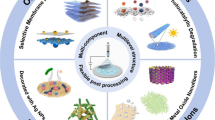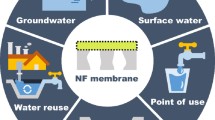Abstract
The fundamental relationship between microstructure, constituent, processing and performances of separating materials is really a vital issue. Traditional preparation methods for separation membranes are complex, time-consuming and easy to be fouled. Also, the durability of conventional coatings on membrane is poor. By combination of bioinspiration from mussel adhesive and fish scales’ underwater superoleophobicity, we propose a general route to prepare organic-inorganic hybrid coatings, while no complex apparatus is needed. Specifically, based on the biomimetic adhesion of polydopamine (PDA), we used it as a binder to adhere TiO2 nanoparticles and built rough microstructure on fabric. In this way, we obtained TiO2-PDA treated fabric with special wettability. These TiO2-PDA treated samples owned superamphiphilicity in air, underwater superoleophobicity (underwater oil contact angles (OCAs) > 150°), underoil superhydrophobicity (underoil water contact angles (WCAs)> 150°), excellent multiresistance; and can separate polar/nonpolar liquid mixture effectively. It also owned superaerophobicity underwater (underwater bubble contact angles (BCAs) > 150°). The proposed TiO2-PDA coatings are highly expected to be employed for real situation of water pollution remediation, self-cleaning, oil extraction and harsh chemical engineering issues.
Similar content being viewed by others
References
Si Y, Dong Z, Jiang L. Bioinspired designs of superhydrophobic and superhydrophilic materials. ACS Central Science, 2018, 4(9): 1102–1112
Liu N, Chen Y, Lu F, et al. Straightforward oxidation of a copper substrate produces an underwater superoleophobic mesh for oil/water separation. ChemPhysChem, 2013, 14(15): 3489–3494
Li J, Yan L, Li H, et al. Underwater superoleophobic palygorskite coated meshes for efficient oil/water separation. Journal of Materials Chemistry A: Materials for Energy and Sustainability, 2015, 3(28): 14696–14702
Kontturi E, Laaksonen P, Linder M B, et al. Advanced materials through assembly of nanocelluloses. Advanced Materials, 2018, 30(24): 1703779
Huang P, Wu F, Shen B, et al. Biomimetic porous polypropylene foams with special wettability properties. Composites Part B: Engineering, 2020, 190: 107927
Si Y, Guo Z. Superwetting materials of oil-water emulsion separation. Chemistry Letters, 2015, 44(7): 874–883
Peng Y, Guo Z. Recent advances in biomimetic thin membranes applied in emulsified oil/water separation. Journal of Materials Chemistry A: Materials for Energy and Sustainability, 2016, 4(41): 15749–15770
Dudchenko A V, Rolf J, Shi L, et al. Coupling underwater superoleophobic membranes with magnetic pickering emulsions for fouling-free separation of crude oil/water mixtures: An experimental and theoretical study. ACS Nano, 2015, 9(10): 9930–9941
Zhang W, Zhu Y, Liu X, et al. Salt-induced fabrication of superhydrophilic and underwater superoleophobic PAA-g-PVDF membranes for effective separation of oil-in-water emulsions. Angewandte Chemie International Edition, 2014, 53(3): 856–860
Arumugham T, Kaleekkal N J, Rana D, et al. Separation of oil/water emulsions using nano MgO anchored hybrid ultrafiltration membranes for environmental abatement. Journal of Applied Polymer Science, 2016, 133(1): 42848
Zhao Y, Zhang M, Wang Z. Underwater superoleophobic membrane with enhanced oil-water separation, antimicrobial, and antifouling activities. Advanced Materials Interfaces, 2016, 3(13): 1500664
Wang S, Liu K, Yao X, et al. Bioinspired surfaces with superwettability: New insight on theory, design, and applications. Chemical Reviews, 2015, 115(16): 8230–8293
Padaki M, Murali R S, Abdullah M S, et al. Membrane technology enhancement in oil-water separation. A review. Desalination, 2015, 357: 197–207
Liu M, Wang S, Wei Z, et al. Bioinspired design of a superoleophobic and low adhesive water/solid interface. Advanced Materials, 2009, 21(6): 665–669
Chen C, Weng D, Mahmood A, et al. Separation mechanism and construction of surfaces with special wettability for oil/water separation. ACS Applied Materials & Interfaces, 2019, 11(11): 11006–11027
Tie L, Li J, Liu M, et al. Dual superlyophobic surfaces with superhydrophobicity and underwater superoleophobicity. Journal of Materials Chemistry A: Materials for Energy and Sustainability, 2018, 6(25): 11682–11687
Xu Z, Zhao Y, Wang H, et al. A superamphiphobic coating with an ammonia-triggered transition to superhydrophilic and superoleophobic for oil-water separation. Angewandte Chemie International Edition, 2015, 54(15): 4527–4530
Ge B, Ren G, Yang H, et al. Fabrication of BiOBr-silicone aerogel photocatalyst in an aqueous system with degradation performance by sol-gel method. Science China: Technological Sciences, 2020, 63(5): 859–865
Liu M, Li J, Hou Y, et al. Inorganic adhesives for robust superwetting surfaces. ACS Nano, 2017, 11(1): 1113–1119
Kuang Y, Chen C, Chen G, et al. Bioinspired solar-heated carbon absorbent for efficient cleanup of highly viscous crude oil. Advanced Functional Materials, 2019, 29(16): 1900162
Zheng W, Fan H, Wang L, et al. Oxidative self-polymerization of dopamine in an acidic environment. Langmuir, 2015, 31(42): 11671–11677
Guo F, Wen Q, Peng Y, et al. Simple one-pot approach toward robust and boiling-water resistant superhydrophobic cotton fabric and the application in oil/water separation. Journal of Materials Chemistry A: Materials for Energy and Sustainability, 2017, 5(41): 21866–21874
Liu Y, Ai K, Lu L. Polydopamine and its derivative materials: Synthesis and promising applications in energy, environmental, and biomedical fields. Chemical Reviews, 2014, 114(9): 5057–5115
Lv X, Jiao Y, Wu S, et al. Anisotropic sliding of underwater bubbles on microgrooved slippery surfaces by one-step femtosecond laser scanning. ACS Applied Materials & Interfaces, 2019, 11(22): 20574–20580
Yong J, Singh S C, Zhan Z, et al. Substrate-independent, fast, and reversible switching between underwater superaerophobicity and aerophilicity on the femtosecond laser-induced superhydrophobic surfaces for selectively repelling or capturing bubbles in water. ACS Applied Materials & Interfaces, 2019, 11(8): 8667–8675
Huo J, Yang Q, Yong J, et al. Underwater superaerophobicity/superaerophilicity and unidirectional bubble passage based on the femtosecond laser-structured stainless steel mesh. Advanced Materials Interfaces, 2020, 7(14): 1902128
Della Vecchia N F, Luchini A, Napolitano A, et al. Tris buffer modulates polydopamine growth, aggregation, and paramagnetic properties. Langmuir, 2014, 30(32): 9811–9818
Xue Z, Cao Y, Liu N, et al. Special wettable materials for oil/water separation. Journal of Materials Chemistry A: Materials for Energy and Sustainability, 2014, 2(8): 2445–2460
Wang B, Liang W, Guo Z, et al. Biomimetic super-lyophobic and super-lyophilic materials applied for oil/water separation: A new strategy beyond nature. Chemical Society Reviews, 2015, 44(1): 336–361
Liu Z, Qin D, Zhao J, et al. Efficient oil/water separation membrane derived from super-flexible and superhydrophilic core-shell organic/inorganic nanofibrous architectures. Polymers, 2019, 11(6): 974
Salomäki M, Marttila L, Kivelä H, et al. Effects of pH and oxidants on the first steps of polydopamine formation: A thermodynamic approach. The Journal of Physical Chemistry B, 2018, 122(24): 6314–6327
Liebscher J, Mrówczyński R, Scheidt H A, et al. Structure of polydopamine: A never-ending story? Langmuir, 2013, 29(33): 10539–10548
Zhao J, Xu J, Jian X, et al. NIR light-driven photocatalysis on amphiphilic TiO2 nanotubes for controllable drug release. ACS Applied Materials & Interfaces, 2020, 12(20): 23606–23616
Wang Z X, Yang H C, He F, et al. Mussel-inspired surface engineering for water-remediation materials. Matter, 2019, 1(1): 115–155
Lin X, Chen Y, Liu N, et al. In situ ultrafast separation and purification of oil/water emulsions by superwetting TiO2 nanocluster-based mesh. Nanoscale, 2016, 8(16): 8525–8529
Ikoma T, Kobayashi H, Tanaka J, et al. Microstructure, mechanical, and biomimetic properties of fish scales from Pagrus major. Journal of Structural Biology, 2003, 142(3): 327–333
Peng T, Zhang J, Ray S, et al. Optimizing one-dimensional TiO2 for photocatalytic hydrogen production from a water-ethanol mixture and other electron donors. Journal of Environmental Chemical Engineering, 2019, 7(1): 102868
Bickley R I, Gonzalez-Carreno T, Lees J S, et al. A structural investigation of titanium dioxide photocatalysts. Journal of Solid State Chemistry, 1991, 92(1): 178–190
Kang S, Baginska M, White S R, et al. Core-shell polymeric microcapsules with superior thermal and solvent stability. ACS Applied Materials & Interfaces, 2015, 7(20): 10952–10956
Chen J H, Zhou Y, Zhou C L, et al. A durable underwater superoleophobic and underoil superhydrophobic fabric for versatile oil/water separation. Chemical Engineering Journal, 2019, 370: 1218–1227
Jung Y C, Bhushan B. Wetting behavior of water and oil droplets in three-phase interfaces for hydrophobicity/philicity and oleophobicity/philicity. Langmuir, 2009, 25(24): 14165–14173
Karagounis G. Separation of polar from non-polar molecules. Nature, 1948, 161(4100): 855
Shan X, Liu J, Mu H, et al. An engineered superhydrophilic/superaerophobic electrocatalyst composed of the supported CoMoSx chalcogel for overall water splitting. Angewandte Chemie International Edition, 2020, 59(4): 1659–1665
Zheng Z, Yang H, Cao Y, et al. Laser-induced wettability gradient surface of the aluminum matrix used for directional transportation and collection of underwater bubbles. ACS Omega, 2020, 5(1): 718–725
Chen M Y, Jia Z H, Zhang T, et al. Self-transport of underwater bubbles on a microholed hydrophobic surface with gradient wettability. Soft Matter, 2018, 14(36): 7462–7468
Liang M, He C, Dai J, et al. A high-strength double network polydopamine nanocomposite hydrogel for adhesion under sea-water. Journal of Materials Chemistry B: Materials for Biology and Medicine, 2020, 8(36): 8232–8241
Cheng C, Li S, Nie S, et al. General and biomimetic approach to biopolymer-functionalized graphene oxide nanosheet through adhesive dopamine. Biomacromolecules, 2012, 13(12): 4236–4246
Fox M A, Chen C C, Younathan J N N. Oxidative cleavage of substituted naphthalenes induced by irradiated semiconductor powders. Journal of Organic Chemistry, 1984, 49(11): 1969–1974
Atta A M, Shaker N O, Maysour N E. Influence of the molecular structure on the chemical resistivity and thermal stability of cured Schiff base epoxy resins. Progress in Organic Coatings, 2006, 56(2–3): 100–110
Ma L, He J, Wang J, et al. Functionalized superwettable fabric with switchable wettability for efficient oily wastewater purification, in situ chemical reaction system separation, and photo-catalysis degradation. ACS Applied Materials & Interfaces, 2019, 11(46): 43751–43765
Liu C, Takagi R, Shintani T, et al. Organic liquid mixture separation using an aliphatic polyketone-supported polyamide organic solvent reverse osmosis (OSRO) membrane. ACS Applied Materials & Interfaces, 2020, 12(6): 7586–7594
Ge B, Han L, Gao B, et al. A mesoporous SiO2/TiO2 composite used for various emulsions separation. Separation Science and Technology, 2019, 54(6): 962–969
Acknowledgement
This work was supported by the National Natural Science Foundation of China (Grant No. 51705138).
Author information
Authors and Affiliations
Corresponding author
Additional information
Disclosure of potential conflicts of interest
The authors declare that they have no conflict of interest.
Rights and permissions
About this article
Cite this article
Chen, G., Chen, S., Zhang, X. et al. Twofold bioinspiration of TiO2-PDA hybrid fabrics with desirable robustness and remarkable polar/nonpolar liquid separation performance. Front. Mater. Sci. 15, 124–137 (2021). https://doi.org/10.1007/s11706-021-0534-z
Received:
Accepted:
Published:
Issue Date:
DOI: https://doi.org/10.1007/s11706-021-0534-z




